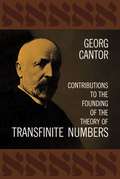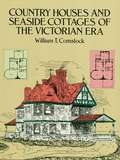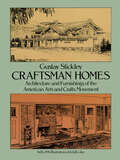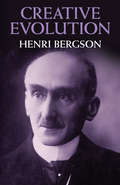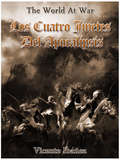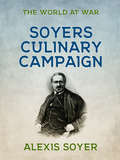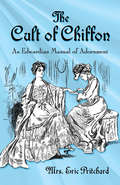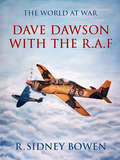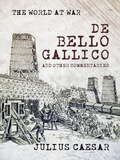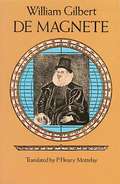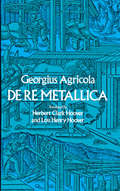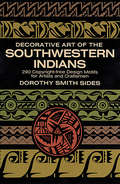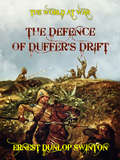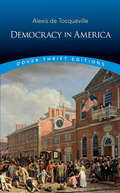- Table View
- List View
Contributions to the Founding of the Theory of Transfinite Numbers (Dover Books on Mathematics)
by Georg CantorOne of the greatest mathematical classics of all time, this work established a new field of mathematics which was to be of incalculable importance in topology, number theory, analysis, theory of functions, etc., as well as in the entire field of modern logic. It is rare that a theory of such fundamental mathematical importance is expressed so simply and clearly: the reader with a good grasp of college mathematics will be able to understand most of the basic ideas and many of the proofs.Cantor first develops the elementary definitions and operations of cardinal and ordinal numbers and analyzes the concepts of "canlinality" and "ordinality." He covers such topics as the addition, multiplication, and exponentiation of cardinal numbers, the smallest transfinite cardinal number, the ordinal types of simply ordered aggregates, operations on ordinal types, the ordinal type of the linear continuum, and others. He then develops a theory of well-ordered aggregates, and investigates the ordinal numbers of well-ordered aggregates and the properties and extent of the transfinite ordinal numbers.An 82-page introduction by the eminent mathematical historian Philip E. B. Jourdain first sketches the background of Cantor's theory, discussing the contributions of such predecessors as Veicrstrass, Cauchy, Dedekind, Dirichlet, Riemann, Fourier, and Hankel; it then traces the development of the theory by summarizing and analyzing Cantor's earlier work. A bibliographical note provides information on further investigations in the theory of transfinite numbers by Frege, Peano, Whitehead, Russell, etc.
Country Houses and Seaside Cottages of the Victorian Era
by William T. ComstockThis fascinating book presents a series of 44 designs for vacation homes of varying styles and sizes, created over a century ago by a select group of New York and New Jersey architects. Many of them are two-story, and most were intended to be built on low-to-medium budgets. All of them reflect the ideals of comfort and charm and state-of-the-art technology of the Victorian period.The original publishers compiled a splendid variety of designs, presented them as "seaside and country houses" and included designs for a Victorian club house, pavilion, school house, and a "small seaside chapel." A total of 200 illustrations -- including perspective views, front and side elevations, and first- and second-story floor plans -- depict these appealing designs. Occasionally the architects have specified construction materials and finishing details such as paint, color, and trim, and in all cases they have included the overall anticipated costs, which range from about $500 to about $9,000.The Victorians, of course, loved architectural embellishments of every kind, and it is no small part of the charm of this book to study the profusion of gables, porches, portholes, dormers, porticoes, chimneys, pinnacles, and more, lavished on even the most modest designs. Above all, the houses and cottages appear to be both comfortable and reassuring, appealing reminders of a gracious age long gone. Those studying and working in the fields of architecture, history, and sociology will find in this wonderful book exuberant examples of a rich and charming architectural style. Those who wish to join the growing number of home builders and restorers re-creating Victorian homes will find inspiration in each of these thoughtful designs.
The Cowboy at Work: All About His Job And How He Does It
by Fay E. WardA self-described horse wrangler, bronc breaker, and rough-string rider for cow outfits from Canada to the Mexican border, old-time cowboy Fay Ward simply yet vividly describes every detail of the working cowhand's life and job. Want to know how to throw a half-diamond hitch and wield a branding iron? How about learning how to trap wild mustangs and rig and use a saddle? Interested in the recipe for S. B. stew? This authoritative manual explains it all. Illustrated with 600 drawings and diagrams by the author, this is a captivating and informative read for working cowboys, dude ranch wranglers, armchair bronc-busters, and anyone interested in cowboy life and lore.
Craftsman Bungalows: Designs from the Pacific Northwest (Dover Architecture Ser.)
by Yoho MerrittFrom the late nineteenth century to the early 1920s, the Arts and Crafts Movement spread with great popularity across America. With origins in Britain, the Craftsman style was a reaction against the excesses of the Victorian era. Craftsman bungalows were distinguished by their charming simplicity, cozy style, and storybook appeal. The name was derived from a popular magazine called The Craftsman, published by renowned furniture designer Gustav Stickley who sold plans for these homes designed for "beauty, convenience, and comfort." This fascinating reprint of a rare architectural catalog is filled with photos of actual completed bungalows from the era, built prior to 1919. A mix of Spanish tile, stucco exteriors, wraparound porches, overhanging gables, handcrafted stone, and woodwork added up to many a homeowner's dream. Geared to the climate of the northern and eastern regions, each bungalow is an authentic Craftsman design and features a photo, description, floor plan, and original costs. A fascinating showcase of primary American architecture, Craftsman Bungalows is an indispensable resource for architects, builders, historians, and illustrators.
Craftsman Homes: Architecture and Furnishings of the American Arts and Crafts Movement
by Gustav Stickley296 architectural drawings, floor plans, and photographs illustrate 40 different kinds of "Mission-style" homes from The Craftsman (1901-16), voice of American style of simplicity and organic harmony. Thorough coverage of Craftsman idea in text and picture, now collector's item.
Creative Evolution
by Henri BergsonThe most famous and influential work of distinguished French philosopher Henri Bergson (1859–1941), Creative Evolution features the fullest expression of the philosopher's ideas about the problem of existence, propounding a theory of evolution completely distinct from these of earlier thinkers and scientists.In discussing the meaning of life, Bergson considers the order of nature and the form of intelligence, including the geometrical tendency of the intellect, and examines mechanisms of thought and illusion. In addition, he presents a critique of the idea of immutability and the concept of nothingness, from Plato and Aristotle through the evolutionism of his contemporaries.Bergson's influence on Marcel Proust and other twentieth-century writers renders a grasp of his theories imperative to students of literature as well as philosophy. Historians of science and other readers will also appreciate the importance of this milestone in philosophical and evolutionary thought.
Creative Power of Silence
by Swami ParamanandaSilence, the great unseen power, the miracle of life, works upon our character with strange contrast.Prior to spiritual studies, the idea of complete silence is strongly advocated by many. In practicing the silence, it is found to unfold our higher nature. The silence allows concentration. With the intrusion of noise, the mind cannot be receptive.Contrary to some belief, the silence is not to free the mind to allow emptiness. It means co-ordination of body and mind. It reduces friction and becomes a definite factor for our concentrated thought. The silence is essential for all forms of study. “A silent being is a very restful being. All wise people realize the deeper part of our nature can only be expressed effectively when our outer being is still.”
A Critical Exposition of the Popular 'Jihád' (The World At War)
by Cherágh AliA Critical Exposition of the Popular 'Jihád' Showing that all the Wars of Mohammad Were Defensive; and that Aggressive War, or Compulsory Conversion, is not Allowed in The Koran - 1885
The Cruise of the Snark (Dover Maritime Series)
by Jack LondonBarely 30 years old and the wildly popular author of The Call of the Wild, Martin Eden, and other successful novels, Jack London's determined to follow the example of his boyhood idol, Herman Melville, and explore the islands of the South Pacific. Accompanied by his wife and two crew members, London set sail from San Francisco in 1906 aboard the Snark, a custom-made 55-foot ketch.With wry good humor, London recounts both the exhilaration and hardship of a two-year voyage aboard a small, leaky craft. His vital, colorful narrative carries readers along with the intrepid crew through stormy seas, illness, and navigational uncertainty. These difficulties are counterbalanced by abundant rewards, including panoramic vistas of the natural beauties of Hawaii, Bora Bora, Tahiti, the Marquesas Islands, and other exotic locales. The hospitality of the South Pacific islanders proves even more overwhelming than the scenery; everywhere the Snark ventures, its crew is greeted with feasts, celebrations, and lavish expressions of goodwill.Enhanced with 119 original photographs, this rollicking blend of excitement and adventure represents one of the most interesting and best-written narratives of a sea voyage ever written. Related in the compelling voice of a master storyteller, The Cruise of the Snark promises a memorable reading experience for armchair sailors, old salts, and any lover of nautical adventure.
Los cuatro jinetes del apocalipsis: Centenario De La Primera Guerra Mundial (The World At War #425)
by Vicente IbáñezSe trata de una novela ambientada en 1914 en Francia y narra las vicisitudes de la Primera Guerra Mundial. El punto de vista es el de un natural de un país neutral aunque claramente decantado por el lado francés de los Aliados frente a Alemania. Debido a sus diferencias políticas, dos familias provenientes de un tronco común, los Desnoyers y los Von Hartrott, se enfrentan. Tras la muerte del patriarca, Julio Madariaga, los Hartrott se marchan a Alemania y los Desnoyers a Francia. Ambas familias terminan combatiendo en bandos opuestos en la Primera Guerra Mundial. La novela discurre ágilmente por los escenarios dantescos de una Europa rota, sobre cuyos desolados campos de batalla el gran vitalista que fue Blasco hace latir finalmente, salvaje e invencible, el deseo de vivir.
A Culinary Campaign (The World At War)
by Alexis SoyerSoyer's brilliant memoir, a vivid account of the Crimean War and of Soyer's inventions and recipes for feeding armies in the field. He was as important in the Crimea as Florence Nightingale, for his influence on the reform of army feeding enabled wounded soldiers to survive. A modified version of the Soyer stove was still in use in the Gulf War. (Goodreads)
The Cult of Chiffon: An Edwardian Manual of Adornment
by Mrs Marian Elizabeth Pritchard Rose Le Quesne"The subject of woman, that is to say, the modern woman, with her varying instincts, pursuits, and peculiarities alone would fill many large volumes. I feel bound, therefore, to confine myself to the discussion of one particular side of her nature, one for which personally I have most sympathy, and one which perhaps can best be described by the epithet 'womanly.'"Originally published in 1902, this extremely rare volume offers a remarkable snapshot of the fashionable Edwardian woman. The author — fashion editor for The Lady's Realm, a monthly London magazine for more "enlightened" readers — offers rich counsel on how to cultivate charm and social standing through the subtle art of dress. Illustrated fashion tips feature a wide range of advice on corsets, petticoats, hats, jewelry, footwear, accessories, and more, with chapters on "The All-Important Question of Colour," "Hats Sublime and Ridiculous," "The Revival of Fashions of the Past," and "The Aggressiveness of the Smart Woman." A selection of vintage advertisements for London-area fashion shops is also included.
The Cultural Life of the American Colonies
by Louis B. WrightAuthoritative and perceptive, this sweeping survey covers 150 years of cultural evolution in colonial America, from 1607 to 1763. Developments in religion, literature, education, and social thought receive a thorough analysis, enlivened by a blend of wit and panache that captures all the excitement of forming a new civilization. <p><p> Written by a distinguished scholar and educator who served as director of the Folger Shakespeare Library and specialized in the colonial era, this volume addresses a broad array of topics: the region's agrarian society and leadership; influence of non-English elements; variety of religions and zeal for education; reading habits and the desire for learning; literary production in the North and South; drama, music, and other diversions; architecture and the decorative arts; scientific interests and observations; and many other fascinating subjects.
Curious Punishments of Bygone Days
by Alice Morse EarleColonial American justice was harsh with transgressors: liars were bound to the whipping-post and scolding women sentenced to the ducking stool. Derived from court records, newspapers, diaries, and letters, this illustrated volume offers authentic views of many traditional forms of chastisement.These punitive measures were taken against petty thieves, unruly servants, Sabbath-breakers, revilers, gamblers, drunkards, ballad-singers, fortune-tellers, and other offenders against the rigid social code of early America. "Engines of punishment" included the stocks, the pillory, the infamous scarlet letter, and other forms of public humiliation. From book burnings to brandings, this unusual book offers arresting insights into colonial concepts of crime and punishment.
The Damascus Chronicle of the Crusades: Extracted and Translated from the Chronicle of Ibn Al-Qalanisi
by H. A. GibbA Saracen stronghold throughout the long history of the Crusades, Damascus served as the capital city for Nur al-Deen, Saladin, and other medieval Muslim leaders. From this prime vantage point comes a remarkable contemporary account of the early Crusades, written by one of the city's leading citizens. Ibn Al-Qalānisī, a distinguished scholar of literature, theology, and law, was twice elected mayor of Damascus. His Chronicle begins in 1097, in the early years of the First Crusade, and concludes in 1159, the year before his death at the age of 90.An informative introduction sets the scene just prior to invasion by the Crusaders. The colorful narrative relates the particulars of life during wartime; in addition to his accounts of battles, blockades, and diplomatic negotiations, Ibn Al-Qalānisī paints vivid and decidedly biased portraits of the personalities on both sides of this holy war, from gallant commanders and intrepid troops of his native land to their opposition, the "infidels" and :accursed ones."The author based his work on both written documentation and oral reports, the latter sometimes transcribed from the lips of actual participants. Intended primarily as a textbook for students, this translation by H. A. R. Gibb renders the Arabic text as literally as possible, with minimal annotation, and constitutes an indispensable resource for anyone who needs a firsthand account of the early Crusades.
Daughter of Earth
by Agnes SmedleyWritten in 1929 by a dedicated social activist, it chronicles a woman's escape from grinding rural poverty into a predominantly male world of politics and revolution. "My aim in life was to study, not to follow a man around," asserts Marie Rogers, who struggles to establish her identity as an individual and as "a daughter of the earth," in restless pursuit of equality and justice.Marie's hardscrabble childhood and her involvement with freedom fighters of India and China reflect the author's own experiences. Agnes Smedley (1892–1950) drew upon her own search for spiritual consciousness in this powerful exploration of race, class, and sex in early twentieth-century America. Smedley's novel fell into obscurity after her death, only to reemerge decades later as a remarkable tale of a working-class woman's heroic transformation into an agent for social change.
Dave Dawson with the R.A.F (The World At War)
by R. BowenExcerpt: "I say, but am I fed up to the teeth with the blasted paper work that goes with this kind of a job!" he groaned. "Not at all like in the last mess we had with Jerry. A chap could fly every day, then, regardless of rank."
Days With Ulanova: An Intimate Portrait of the Legendary Russian Ballerina (Dance Ser.)
by Albert KahnIn the great world of dance, Galina Ulanova is considered by many to be as great, if not greater, than Pavlova. Onstage, the miracle of her performances has enraptured vast audiences. But offstage, to the millions of her devotees, she remains an enigma. This exceptional biography—one of a kind—explores the world of Ulanova, and offers a unique look at the woman behind the legend.As a result of his friendship with Ulanova, writer-photographer Albert E. Kahn had the singular opportunity to study Ulanova as dancer, teacher, performer, warm friend, and a shy, modest woman seeking solitude among her beloved birch groves in the Russian countryside. Kahn has captured it all in words and pictures—from the magnificent performances to the intimate glimpses of her day-to-day life.“Days with Ulanova is the most exciting ballet book I have ever seen.”—Anatole Chujoy, Editor of The Dance Encyclopedia“All lovers of the dance, as well as libraries, museums and schools, will welcome this treasure of a book.”—Arthur Todd, New York Times“Mr. Kahn’s work is without precedent in the theatre world. His photographs of Ulanova are undoubtedly the finest imaginary job of visual commentary on any dancer.”—Genevieve Oswald, Curator Dance Collection, Library & Museum of Performing Arts, Lincoln Center“The particular treasure of her life has been lovingly and sensitively apprehended. Mr. Kahn has made us all a wonderfully valuable gift.”—Dance Magazine“This book must rank among the half-dozen most beautiful books on ballet ever published…a monument and a memorial.”—P. W. Manchester, Dance News
De Bello Gallico and other Commentaries: (the War Commentaries Of Julius Caesar: The War In Gaul And The Civil War) (The World At War)
by Julius CaesarDe Bello Gallico and Other Commentaries (The War Commentaries of Julius Caesar: The War in Gaul and The Civil War)' is a collection of war writings by Julius Caesar. Included in this volume are the first hand recollections of one the most important figures in the history of human civilization, Julius Caesar. (Goodreads)
De Magnete
by William GilbertMuch of modern science is based upon the theories and discoveries of William Gilbert, the brilliant English physician and physicist who was the first great experimental scientist. Gilbert was the first to use the word "electricity," to recognize mass as distinct from weight, to discover the effect of heat upon magnetic bodies, to differentiate clearly between static electricity and magnetism, and to explain phenomena of terrestrial magnetism in terms of the earth as a giant magnet.In 1600 he published De Magnete in Latin. As lively and entertaining as it was scientifically scrupulous, it summarized everything that had previously been known about electricity and magnetism, founded a new science and earned Gilbert the title of "the father of modern electricity." In it Gilbert explores magnetism and electricity, lodestones, phenomena of magnetism, direction of the earth's magnetic lines of force, variation in the compass, dip, the concept of the earth as a giant magnet, and much else.This Dover edition is a complete, unabridged reprinting of the definitive English translation of De Magnete prepared by Dr. P. Fleury Mottelay. Dr. Mottelay has added a number of footnotes that explain points that might be obscure to today's readers, who will find in this historically important text invaluable insights into the origins of modern science and physics. Translation by P. F. Mottelay. Biographical introduction. 90 illustrations.
De Re Metallica: De Re Metallica. Libri Xii. . . (Dover Earth Science)
by Georgius AgricolaOriginally published in 1556, Agricola's De ReM etallica was the first book on mining to be based on field research and observation — what today would be called the "scientific approach." It was therefore the first book to offer detailed technical drawings to illustrate the various specialized techniques of the many branches of mining, and the first to provide a realistic history of mining from antiquity to the mid-sixteenth century. For almost 200 years, Agricola remained the only authoritative work in this area and by modern times it had become one of the most highly respected scientific classics of all time. A book more often referred to in literature on mining and metallurgy than any other, its Latin text prevented it from being as widely used as it might have been. <p><p> In 1912, the book was translated by former President Herbert Clark Hoover and his wife. Printed in a limited edition, the work was quickly bought up by book collectors, historians, and medievalists, who had found that there was much to be learned from its pages. The book contains an unprecedented wealth of material on alluvial mining, alchemy, silver refining, smelting, surveying, timbering, nitric acid making, and hundreds of other phases of the medieval art of metallurgy. The text even covers the legal aspects of mining the use of boundary stones, forfeitures of titles, safety requirements of tunnel building in the 1500s, and so on. <p> But the plates, perhaps more than anything else, have insured Agricola's continued importance. Brilliantly executed drawings, richly detailed, reveal a whole medieval world of machinery, industrial technique, tools, even costume and architecture. All 289 of the original woodcuts are reproduced in this reprint of the 1912 edition, offering students of the period, commercial artists, engineers, metallurgists, and even curious general readers an unforgettable picture of the first age of technology.
Decorative Art of the Southwestern Indians
by Dorothy S. SidesThe decorative art of the Indians of the American Southwest has long been recognized as one of the most beautiful art traditions in the primitive world. It demonstrates a technical skill with simple materials, a symbolic richness, and a faculty for creating rich effects by the imaginative use of ornament that are all almost unique. Museums use Pueblo ceramics for display pieces, and modern artists and crafters have turned eagerly to the handwork of prehistoric Indian women for inspiration and working ideas.Mrs. Dorothy Sides, a noted artist and collector, has gathered together and redrawn in black and white nearly 300 examples of the finest authentic Southwestern Indian decoration that she has seen in a lifetime of study. She has not limited her selection to one period or style, however; to make her book as useful as possible, she has selected material ranging from the thirteenth century great geometric art of the Pueblos to the handcrafts carried on by the nomadic and Pueblo peoples of the present.The main emphasis of this volume is on ceramic decoration, and Mrs. Sides includes pieces from the rich archeological sites of Pecos, Sikyatki, the Mimbres, and modern Pueblo pottery from Acoma, Zuni, Cochiti, and the Hopi. She also includes designs and motifs from the basketry of the Apache, Pima, and Papago; beadwork from the Mohave; authentic Zuni masks; Hopi kachina dolls; and sand paintings and blanket designs from the Navajo. This broad coverage of beautiful ornament illustrates many different art styles to fit every situation: geometric designs based upon balanced mirror fields of design, symbolic figures of the thunderbird, and modern stylizations. All is beautiful and imaginative.Any crafter working with ceramics will find this book indispensable as a source of rich, easily used, powerful design; workers in wood, weavers, metal workers, and leather workers will find that it will enlarge their decorative resources considerably. It also offers unusual and eye-catching designs for commercial artists who wish to do work suggesting travel, handcrafts, the Southwest, or the social sciences. Individual drawings are royalty-free and may be reproduced without fee or permission.
The Defence of Duffer's Drift (The World At War)
by Ernest Swinton"The Defence of Duffers Drift" is a fictional account of a young, inexperienced British officer, who is tasked with holding a river crossing with 50 troops against a larger enemy force. His initial failures and eventual victory serve as an entertaining and instructive vehicle to convey the principles of small unit tactics. Because it deals with principles, this definitive work has endured to this day and is still on some of the required reading lists of the U.S. Army and Marine Corps. (Goodreads)
Democracy in America: Complete, Unabriged Vol. 1 And Vol. 2 (Dover Thrift Editions)
by Alexis De Tocqueville Henry Reeve Francis BowenIn the early 19th century, a French sociologist and political scientist undertook a seven-month journey throughout the newly formed United States. Alexis de Tocqueville surveyed the young nation's religious, political, and economic character and reported his findings in two volumes, published in 1835 and 1840. Two centuries later, Democracy in America remains among the most astute and influential surveys of American politics and society. de Tocqueville focuses on why republican representative democracy prevailed in the United States, tracing its success from the state of equality established by the early Puritan settlers through the American Revolution and adoption of the Constitution. His speculations on the future of democracy offer prescient, thought-provoking reading, and his classic work remains a touchstone for modern thinkers on government. This edition is based on the earliest approved translation, which has served as the standard version for over a century and comes closest to reflecting the author's insights as perceived by his contemporaries.
Designs for Street Fronts, Suburban Houses and Cottages (Dover Architecture)
by C. C. Miller M. F. CummingsExcellent sourcebook includes elevations of building fronts as well as enlarged drawings of architectural elements incorporated in these facades: residential entrances, cornices, a curved roof, dormer window, and much more. Indispensable archive for preservationists, restorationists, architectural historians, and urban archaeologists. 714 illustrations on 52 plates.
